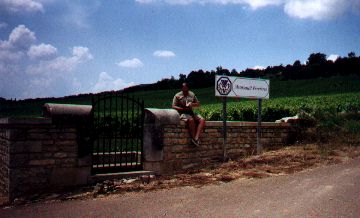|
Domaine des Comtes Lafon Last updated: 18-11-97 |
|
|
Domaine des Comtes Lafon Last updated: 18-11-97 |
|
Contents:
|
 At the Meursault Perrieres Vineyard (july '97) |
| Introduction
|
This Burgundy domaine is situated in
Meursault, Cote d'Or. It was founded by Jules Lafon, the
grandfather of Dominique Lafon, who is currently in
charge and has been since the early eighties. Lafon's
glorious reputation can best be described as the result
of posession of a select array of vineyards and an utter
dedication to quality supported by the technical skill to
make such dedication effective. No real philosophy of
winemaking here; one leans on the well recorded
experience of years, yet never avoids the (small and
never issued) experiment in order to find further
improvements. Low yields and old vines are considered the
minimum to start working with. And that work results in
beautifully intense wines that however take years to
fully show their potential. Another unfortunately hard thing is obtaining Lafon's wines. When visiting the domaine in 1994 it was explained that their usual production of around 60.000 bottles/year attracts about ten buyers a bottle. |
| Vineyard holdings | |||
| Vineyard | Status | Area (in ha) | Age of vines (years) |
| Le Montrachet | Grand Cru | 0,33 | 30-50 |
| Meursault Les Perrieres | Premier Cru | 0,75 | 40 |
| Meursault Les Charmes | Premier Cru | 1,75 | 40-70 |
| Meursault Les Genevrieres | Premier Cru | 0,55 | 45 |
| Meursault Goutte d'Or | Premier Cru | 0,33 | replanted 1990 |
| Meursault Clos de la Barre | Lieu-dit | 2,10 | 35 |
| Meursault En la Barre | Lieu-dit | 0,60 | 40 |
| Meursault Desiree | Lieu-dit | 0,50 | 25 |
| Volnay Santenots-du-Milieu | Premier Cru | 3,75 | 33-40 |
| Volnay Clos des Chenes | Premier Cru | 0,33 | 25 |
| Volnay Les Champans | Premier Cru | 0,50 | 70 (2 thirds of vineyard) 8 (1 third of vineyard) |
| Monthelie les Duresses | Premier Cru | 1,00 | 9-20 |
Information in this paragraph obtained from "The Great Domaines of Burgundy", by Remington Norman, Kyle Cathie Limited, London, second edition, 1996, page 198.
| Technical
information
|
The tending of the vineyards is done with
as less chemical sprays and herbicides as possible. Low
yields (35 hl/ha or less) are obtained by preferring old
vines (of low yield clones), reduction of fertilisation
and severe pruning. Lafon is often a late picker, going
for high sugar rather than concerning about the acidity
levels. It is believed that the low yield regime always
provides enough acidity. Grapes are hand picked and
pressed pneumatically (slowly and gently though). With
the reds extraction of harsh tannins is avoided always.
Red harvest is destemmed almost completely. Fermentation is done in barrels, 100% new oak for the premiers and grand crus. A heat exchanger is available to control the temperature of the fermentation process. The wines ferment on natural yeasts, the use of sulfuric dioxide being lower than 7g/hl Battonage is used once a week average untill February to March after the harvest. Two rackings are used. One after 6-7 months, together with an assemblage, the second the following spring when the wines are racked off the fine lees as well. Lafon fines very carefully and bottles unfiltered, demanding extra care during transport and subsequent cellaring as well. Total time between harvest and botteling is usually almost two years. |
| Tasting
impressions
|
As one tends to say it is a rare occasion
to drink a Lafon wine that has fully developed its
potential. I am aware that my impressions so far come
only from tasting young(er) wines of Lafon. Yet the span
of life I have so far been able to oversee gives me every
confidence that the critics who so widely laureate these
wines may very well be right. These wines do need a
considerable amout of time to display their full
potential. But it's a wait that is well rewarded. Lafon
makes wines of fabulous intensity, yet also wines that
still manage to express their individual vineyard
background. The reds are perhaps lesser known and
celebrated than the wines. Let's say that I will not
further limit my chances to obtain Lafon's reds by
argueing this statement here. I have once had the
opportunity to visit the domaine, in 1994. I was then
able to taste the full range of Lafon wines, including a
rather unforgettable sip of Montrachet 1993. Comparative
impressions of that tasting in Meursault, as well as some In the third column you will find individually specified notes on Lafon wines I have tasted.
|
1994
Meursault Clos de la Barre
1994 Volnay Santenots-du-Milieu 1993 Meursault Clos de la Barre 1993 Volnay Santenots-du-Milieu 1992 Meursault Clos de la Barre 1992 Volnay Santenots-du-Milieu 1991 Volnay Santenots-du-Milieu |
This page hosted by ![]()